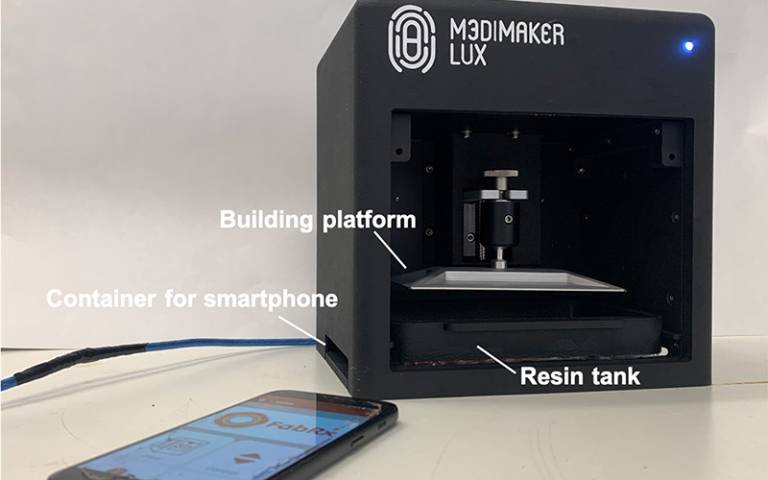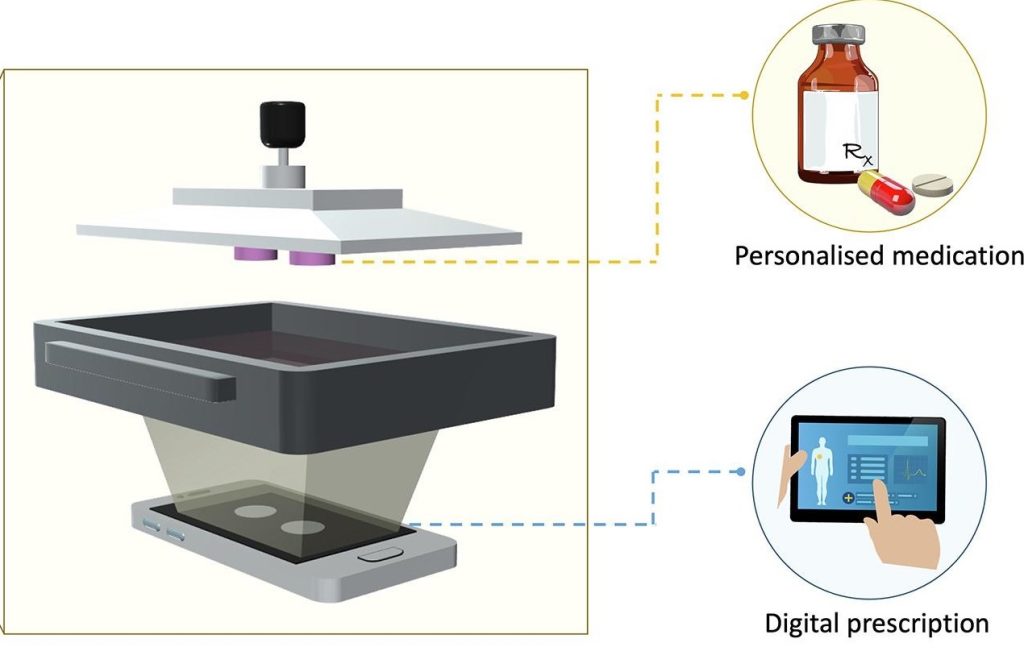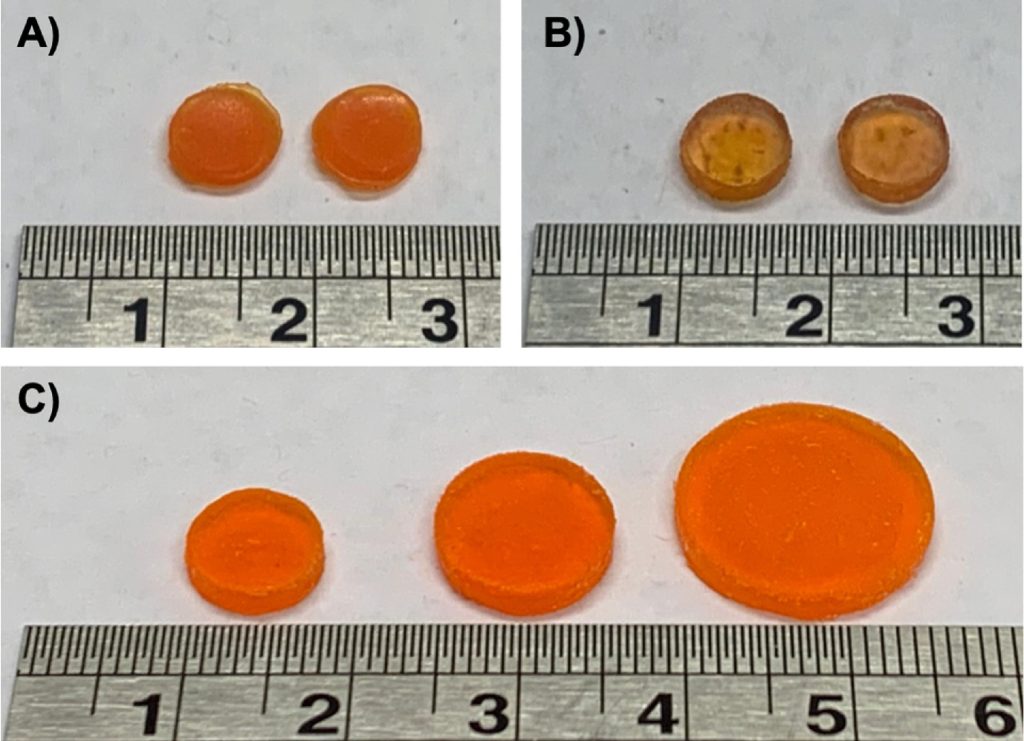Researchers at University College London (UCL), Universidade de Santiago de Compostela (USC) and biopharma firm FabRx, have managed to convert an everyday smartphone into an on-demand personalized drug 3D printer.
Using the visible light created by a mobile phone screen, the modified M3DIMAKER LUX system has already proven capable of 3D printing blood-thinning tablets in specific shapes, sizes and dosages. Operable via a user-friendly app, it’s hoped that with further R&D, the team’s machine could be deployed in future by those living in isolated areas, under the remote supervision of GPs to ensure patient safety.
“This novel system would help people who need precise dosages that differ from how a medication is typically sold, as well as people whose required dosage may change regularly,” said the study’s lead author Xiaoyan Xu. “The tablet’s shape and size are also customizable, which enables flexibility in the rate at which the medication gets released into the bloodstream.”
“It may even be possible to custom-print polypills containing multiple drugs, to reduce pill burdens for elderly patients.”

Accessible drug ‘LCD 3D printing’
In the pharmaceutical sector, 3D printing is increasingly being deployed to create custom medications that can be tailored specifically to meet the needs of certain patients. Aprecia is one of the early leaders in this area, having developed its ZipDose additive manufacturing technology, an approach it uses to produce its fast-dissolving Spritam seizure tablet, the first FDA-approved 3D printed drug.
In more experimental 3D printing applications, researchers in Pakistan have also managed to develop a means of 3D printing antibiotic tablets, in which they can tweak a pill’s infill percentage to change its release rate upon consumption. According to the UCL-led team, methods such as this could become “particularly beneficial” in future when it comes to creating drugs with narrow therapeutic indices, a group that includes other seizure medications like Phenytoin.
Although still at an early stage of development, several different approaches to drug 3D printing are already being tested. For its part, FabRx has previously harnessed SLS additive manufacturing to produce braille-patterned tablets for the visually impaired, while a team at St. John’s University, New York has deployed FFF to manufacture an ‘egg-shaped’ medication, designed to deter opioid abuse.
Another approach that has shown potential in this area is vat photopolymerization LCD 3D printing. In essence, the technology involves shining LED light upwards via an LCD screen, which is used as a ‘mask’ to generate an image of each layer. When the light passes through this filter, only the pixels needed for creating the current layer are shown, in a way that ultimately enables parts to be produced accurately, one layer at a time.
Given the widespread availability of LCD-equipped consumer devices, the UCL-led research team believes such systems could hold great potential as a means of “improving accessibility to healthcare.” However, to truly achieve this, they say that a more user-friendly 3D printer now needs to be developed, which can be operated easily within a home environment.
“Most 3D printers are relatively large, require trained operators, and must be located in a pharmaceutical setting to manufacture dosage forms,” explained the team in their paper. “In order to realize fully the potential of point-of-care manufacturing of medicines, portable printers that are easy to operate are required.”

Entering LCD-powered production
To power their novel LCD printer, the researchers chose to attach a Huawei P10 smartphone to the underside of a FabRx M3DIMAKER LUX system’s resin tank. Connected to the machine using a transparent FEP film, the device was strapped in tightly to ensure that it remained no more than 1cm from its print bed, and optimal printing results could be achieved.
In order to make their setup as easy to replicate as possible, the team also developed a dedicated mobile app for their 3D printer, complete with ‘control,’ ‘print’ and ‘configuration’ functions. Using their application, the researchers made it possible to not only control the movement of their system’s build platform, but print using differently-shaped pre-prepared tablet models, to streamline pill production.
Once assembled, the UCL-led team opted to test their custom printer by creating tablets containing Warfarin, a blood-thinning medication with a highly-reported variability in patient response. Thanks to the flexibility of 3D modeling software, the scientists found they were able to create medication with doses ranging from 7.54 mg to 29.25 mg, showcasing their setup’s drug personalization capabilities.
If their system were to find widespread usage, the researchers acknowledge that controls would need to be put in place to prevent its abuse. However, the team also maintains that given the UK’s Medicines and Healthcare products Regulatory Agency (MHRA) is currently evaluating the viability of distributed drug production, a machine like theirs could yet be applied in hospitals, homes, or GPs’ surgeries.
“We are continuing to refine our technology and improve the safety of the printlets, as well as to build in safeguards such as enabling doctors to remotely monitor a patient’s medical printer to check adherence to a treatment plan,” concluded study co-lead Abdul Basit. “While plenty of challenges remain to bring our vision to life, we hope that 3D printed medications could facilitate point-of-care medicine.”

Smartphone-based AM innovation
With many commercial smartphones now possessing a level of processing power that used to be reserved for desktop computers, they’re increasingly proving useful within experimental 3D printing setups. In July last year, researchers at the University of Otago Christchurch and Harvard Medical School developed a smartphone-based 3D bioprinter, capable of creating patient-specific tissues on-demand.
Scientists at RMIT University, meanwhile, have come up with a 3D printed ‘clip-on’ filter that turns smartphone cameras into powerful microscopes. Designed to be applied as a point of care diagnostic tool or research device for remote healthcare clinics, the unit is said to enable the viewing of specimens as small as 1/200th of a millimeter.
Elsewhere, Kickstarter-funded firm ONO has previously attempted to commercialize a smartphone-powered resin 3D printer of its own, but pulled the plug on its campaign in July 2021. The project’s failure demonstrated the difficulty of bringing such a device to market, as despite having raised $2.3 million in funding, it had only managed to ship a handful of systems by the time it closed down for good.
The researchers’ findings are detailed in their paper titled “Smartphone-enabled 3D printing of medicines,” which was co-authored by Xiaoyan Xu, Alejandro Seijo-Rabina, Atheer Awad, Carlos Rial, Simon Gaisford, Abdul W. Basit and Alvaro Goyanes.
To stay up to date with the latest 3D printing news, don’t forget to subscribe to the 3D Printing Industry newsletter or follow us on Twitter or liking our page on Facebook.
For a deeper dive into additive manufacturing, you can now subscribe to our Youtube channel, featuring discussion, debriefs, and shots of 3D printing in-action.
Are you looking for a job in the additive manufacturing industry? Visit 3D Printing Jobs for a selection of roles in the industry.
Featured image shows the researchers’ smartphone-powered LCD 3D printer. Image via UCL.



